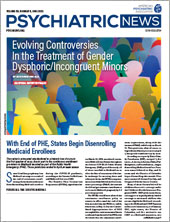One in five deaths by suicide is related to problems with current or former intimate partners such as divorce, separation, romantic breakups, conflicts, and intimate partner violence, a
study in the
American Journal of Preventive Medicine has found.
The results expand understanding of the relationship between intimate partner problems and suicidality, said LCDR Ayana Stanley, Dr.P.H., public health service officer and public health advisor in the Centers for Disease Control and Prevention Division of Violence Prevention, told Psychiatric News.
“Most existing research that focuses on relationship problems and suicidality focuses specifically on intimate partner violence and suicidality,” Stanley said. “This paper looked at factors that were associated with other relationship problems, which also includes general discord and arguments, jealousy, and conflict.”
Stanley and colleagues analyzed data from the National Violent Death Reporting System for 402,391 adults who died by suicide between 2003 and 2020. Of those suicide deaths, 80,717 were known to be related to problems with current or former intimate partners. The researchers compared the circumstances leading up to suicide deaths related to intimate partner problems with suicide deaths not related to intimate partner problems. People whose suicide deaths were related to intimate partner problems had greater odds of the following:
•
6.5 times the odds of having experienced interpersonal violence.
•
4.1 times the odds of having arguments with others such as family, friends, and associates.
•
2.7 times the odds of having a history of suicidal thoughts.
•
2.2 times the odds of interpersonal violence victimization.
•
2.1 times the odds of having a depressed mood.
•
2.0 times the odds of having financial problems.
•
2.0 times the odds of having problematic alcohol use.
•
1.6 times the odds of having recent legal problems.
Aside from problematic alcohol use, there was no significant difference between the two groups regarding other problematic substance use.
“Mental health professionals can use these data to help identify and support people at risk for intimate partner problem–related suicide,” Stanley said. “Key priorities are developing optimal ways of identifying individuals at risk, customizing services to make them more accessible, and engaging people in evidence-based prevention strategies, which can include individualized mental health treatment.”
Among people who died by suicide associated with relationship problems, 85.3% had at least a high school education, 80.2% were White, 78.7% were male, and 49% were 25 to 44 years old. Although the study was not designed to tease out the relationship between demographics and risk of suicide associated with relationship problems, Stanley explained that other research has shown that the greatest proportion of suicides overall are among White males, which could have contributed to the findings in this study.
The researchers noted that the link between relationship problems and suicidality may be bidirectional.
“A partner relationship marked by interpersonal conflict and violence may contribute to or exacerbate mental health problems. Conversely, mental health problems may also contribute to difficulties experienced within an intimate partner relationship,” Stanley and colleagues wrote.
“Additionally, experiencing an acute adverse life event (like deciding to divorce or experiencing intimate partner violence) could contribute to an impulsive suicide attempt among individuals who did not previously have a suicide plan,” the researchers continued. “Thus, monitoring by clinicians, mental health providers, and the helpful connectedness of … family and friends of nonsuicidal individuals encountering severe adverse life events is paramount.”
The researchers reported no outside funding for their work. ■


